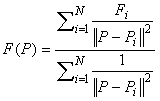Interpolation Method
There are many different methods which can be used to interpolate values from a grid of data specified at X , Y locations. Interpolation implies that the value of a variable can be determined at any required location, based on the defined values at specified locations.
In UnWedge, Interpolation Methods are used for interpolating values of pore pressure for one of the three Water Pressure Grid types:
- Total Head
- Pressure Head
- Pore Pressure
The following Interpolation Methods are available in UnWedge:
Thin Plate Spline
The Thin-Plate Spline method utilizes the concept of an infinite thin elastic plate under tension, to determine a spline surface (a smooth 3-dimensional surface which fits through all of the grid points). The spline surface is used to determine the sample value at any location (Franke, 1985).
Chugh’s Method
The Chugh interpolation method is based on finding the nearest grid point in each of the four quadrants with origin centered at the point where the interpolation is required. A plane is then fit through each combination of three quadrant grid points, and an interpolation is performed for each plane. This results in four interpolations, which are then averaged to obtain the final interpolated value at the desired point (Chugh, 1981).
Modified Chugh
The Modified Chugh method is based on the Chugh method, with the additional requirement that the sample point must be WITHIN the triangle formed by any combination of three quadrant points. If the sample point is NOT within a triangle, then this combination of quadrant points is NOT used. This check insures that EXTRAPOLATED values are not included in the average interpolated value. This avoids numerical inaccuracies which sometimes occur with the original Chugh method, due to excessively large extrapolated values.
The Modified Chugh method is the default Interpolation Method in RS2, as it is a relatively simple, quick and robust method which generally gives good results.
Local Thin Plate Spline
The Local Thin Plate Spline method is an extension of the Thin Plate Spline interpolation technique, and is recommended for use with a large number of grid points (>200). The only difference between the methods is that instead of using all the grid points for the interpolation, the Local version takes a maximum of 10 closest points to the sample point and fits a spline surface through them. The local spline surface is then used to determine the sample value.
TIN Triangulation
TIN Triangulation (Triangulated Irregular Network) takes the grid points and triangulates them using the Delaunay triangulation method. To calculate the value at a sample point, the program first determines which triangle the point lies within. Once the triangle that contains the sample point is found, the interpolated value is calculated using linear interpolation. This is done by calculating the plane equation that fits through the 3 grid points at the triangle vertices, then solving for the value using the coordinates of the sample point and the plane equation.
Inverse Distance
The Inverse Distance Interpolation method weights every grid point according to its distance from the sample point. This scheme is also known as the Shepard method (Shepard, 1968) and can be written in the form:

where P is the location of the sample point, F(P) is the interpolated value at the sample point, Pi the location of the grid points, Fi are the grid point values, and ||P-Pi||2 represents the distance from P to Pi. The main deficiencies of this method are: 1) the local extrema are typically located at the grid points and this results in poor shape properties, and 2) undue influence of grid points which are far away from the sample point.
Linear By Elevation
The Linear by Elevation method only utilizes the elevation (y-coordinate) of each grid point. The method determines the closest grid point (elevation) above the sample point and the closest grid point (elevation) below the sample point, and linearly interpolates the sample value based on these two data points. Interpolation is done in the vertical direction only. This method is meant for horizontally bedded soils where data varies by depth only. It is very useful for cases where a complicated pore pressure profile exists in only the vertical direction. The x-coordinate of the grid points is not used in the interpolation process. However, it is used to display the data on your model.
Secondary Interpolation Methods
In methods such as the TIN Triangulation and the Chugh method, cases exist where interpolation at a sample point cannot be performed.
- In the case of TIN triangulation, an interpolation value cannot be calculated if the sample point lies outside the convex hull of the user-defined grid points.
- In the Chugh method, if one or more of the four quadrants surrounding the sample point does not contain any grid points, then an interpolated value cannot be calculated.
In both these cases, a secondary interpolation method is used. By default in UnWedge, the Local Thin Plate Spline method is used as the secondary interpolation method. If the Local Thin Plate Spline method also fails to determine a value, then the Inverse Distance method is used as a final backup method. This insures that an interpolated value is always calculated at a sample point.
Display of Interpolation Contours
In UnWedge contours of the water pressure grid interpolation results can be displayed from the 3D Wedge View, by right-clicking on a joint and selecting from the Pore Pressure Visualization sub-menu of the right-click menu.
The interpolation results should always be looked at to ensure that the interpolation correctly simulates your field data. If it does not, then either more data points should be used or a different interpolation technique. Since no interpolation method is guaranteed to work for all datasets, different methods should be tried in order to determine the best method for your data.